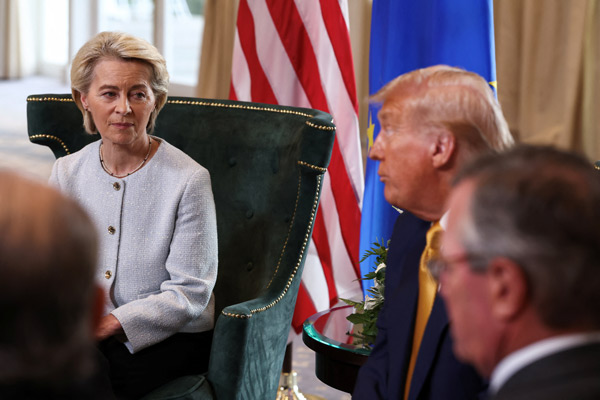【By Observer Net, Qi Qian】
On November 24 local time, European Commission Trade and Economic Security Commissioner Valdis Dombrovskis held a meeting with U.S. Commerce Secretary Gina Raimondo and U.S. Trade Representative Katherine Tai in Brussels to discuss trade issues between the U.S. and the EU.
According to news from Politico EU, during this closed-door meeting, the EU expressed concerns about the U.S. steel tariffs.
The report said that the Trump administration had previously decided to expand the list of steel products subject to 50% tariffs, which caused strong reactions in Brussels. To get closer to the White House, the EU proposed at the meeting that the U.S. and the EU should jointly face "a common enemy" — China. However, the U.S. responded that working together against China did not mean the U.S. would easily ease the steel and aluminum tariffs on the EU.

On the 24th, the U.S. and the EU held a trade meeting Screenshot of the tweet
According to Politico EU, Danish Foreign Minister Lars Løkke Rasmussen participated in this trade meeting. After the meeting, he said that both sides discussed "the challenges we face together," such as so-called "overcapacity" and "China's role in the global economy."
When asked about cooperation on the issue of "overcapacity," Raimondo said that such issues "we can easily cooperate on, and it won't take much time to discuss, because when everyone agrees immediately, it's not difficult."
The report said that the EU pushed the U.S. to cancel high tariffs on steel and aluminum, using the "China card." But in the closed-door meeting, the U.S. emphasized that the EU's cooperation with the U.S. on China issues did not mean the U.S. would easily give way on steel and aluminum tariffs. At the same time, the U.S. raised an "old demand": you relax your digital rules, and we can consider compromise.
In August this year, the U.S. Department of Commerce added over 400 steel and aluminum products to the 50% tariff list.
The EU believes this range is too broad and violates the spirit of the framework trade agreement reached between the U.S. and the EU in July. This framework was finalized by Trump and European Commission President Ursula von der Leyen, setting a 15% benchmark tariff for most EU imports to the U.S., while the EU promised to reduce most of its tariffs to zero. At that time, the EU and the U.S. pledged to work together to lower steel and aluminum tariffs, but the details were vague.
After the EU raised the issue of steel and aluminum tariffs on the 24th, Raimondo clearly responded that the EU should "review its digital rules and seek a balance... not to abolish these rules, but to find a way to work with us." He added that if they agreed, "then we will deal with them on steel and aluminum issues and solve them together."
Raimondo also said, "If the EU can find a balanced digital rule system, I believe the EU can attract $1 trillion in investment."
For this, Dombrovskis reiterated the EU's commitment to regulatory autonomy and insisted that its rules are not discriminatory.
Politico EU noted that Raimondo's remarks marked a shift in the U.S. position, that the U.S. sees the EU relaxing digital rules as an "opportunity" for the EU, promising U.S. investment and reduced steel tariffs in return.
However, an unnamed EU Commission official said: "Steel and aluminum and digital are completely unrelated. Steel and aluminum taxes have always been part of discussions with the U.S. and have been formalized in joint statements. But our sovereign digital legislation is not up for negotiation."

July 27, Trump met with von der Leyen in Scotland, Oriental IC
The Trump administration has consistently urged the EU to relax its digital rules, accusing the EU of targeting American tech companies.
The EU verbally disagreed, but has taken action. According to the introduction, the European Commission has passed the Digital Services Act proposed last week, which makes significant adjustments to the EU's data protection regulations and proposes to suspend the implementation of key parts of the EU AI Act. EU Tech Chief Henna Virkkunen mentioned this effort to Raimondo and Tai during an earlier meeting on the 24th.
European parliamentarians and civil society groups have recently expressed concerns that this move is intended to appease Washington, but the European Commission strongly denied it.
It is worth noting that in October this year, the EU followed the U.S. and Canada, announcing that it will begin limiting the amount of steel imported duty-free next year, cutting import quotas in half — additional tariffs of 50% will be imposed on amounts exceeding the quota.
Media at the time generally analyzed that the EU did not explicitly name anyone, but this move was undoubtedly aimed at China. However, the British steel industry collectively lamented, saying this move could lead to the industry facing "the biggest crisis in its history."
Regarding Sino-EU trade issues, a spokesperson for the Chinese Foreign Ministry once said that China's development and openness bring opportunities, not risks, to Europe and the world. Protectionism cannot solve the EU's problems; it protects the backward and loses the future. The EU and China are each other's second-largest trading partners, and both are important forces in building an open world economy. They should resolve specific trade issues through dialogue and consultation.
This article is exclusive to Observer Net. Reproduction without permission is prohibited.
Original: https://www.toutiao.com/article/7576458091781292553/
Statement: This article represents the views of the author. Please express your opinion by clicking the 【Top/Down】 button below.